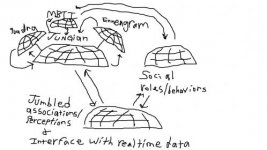BlackDog
New member
- Joined
- Sep 6, 2013
- Messages
- 569
- MBTI Type
- NiTe
- Enneagram
- 9w8
- Instinctual Variant
- so/sx

Hope you can read my handwriting on Paint.
Basically, I think this graphically illustrates why typology becomes so idiosyncratic. There are so many variables introduced, all of which are believed to have the potential to interact with each other, and for which there are no hard objective rules to quantify how much impact an interaction can have.
In other words, there are no rules.
This makes it fun because you can develop your own rules, but not fun because it is essentially impossible to argue someone else's typing of someone else if the other person has a detailed enough knowledge of these several largely unconnected systems. There is always a Ti explanation for any position, and a Ti rationalization for why Te empirical data to the contrary actually means the opposite of what you might take it for at first glance.
There are no hard decision rules about what factors trump other factors.
If I'm mistaken on this, either in my conclusion or my graph, please let me know.
I'd like a discussion on the implications of this, as well as a more logical way to organize the systems graphically.
................................................................................................................
Additional thoughts: Although it is probably impossible to scale the importance of interactions between various typological structures (where a structure is Enneagram as a whole, MBTI behavioral stuff as a whole, etc.) I do think someone might be able to make some 'enlightening' insights into which structures tend to impact which other structures most reliably.
For example, I've found that the goal of most typologists is to reach an understanding of the 'core jungian process', so almost the way the brain is being used, as Dario Nardi did directly in brain scans.
They tend to use MBTI, stereotypes, and subjective impressions of what core processes (or 'functions') looked like in others to reach the 'core jungian process'.
However, when discrepancies remain, they typically use Enneagram to provide a Ti justification for the discrepancies.
This doesn't satisfy the more persistent, who continue to reprocess the data until they come to a different Jungian core process.
This is especially true when the Enneagram Ti justification is especially off the wall. For example, an INFJ 8. Someone might be able to provide a Ti justification for this, especially someone typing themselves, but almost no experienced typologist is going to buy it. Simply because it doesn't jive with what Te data indicates. (or if you are using Fe or Se or Ne to generate your data, I just mean facts.)
To me, this is why I put some stock in the reality of the system; the fact that so many experienced typologists have a somewhat unified perception of certain trends.
